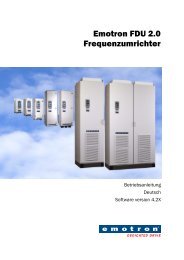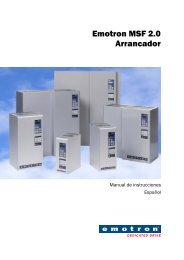You also want an ePaper? Increase the reach of your titles
YUMPU automatically turns print PDFs into web optimized ePapers that Google loves.
Power Factor Control PFC [341]During operation, the softstarter continuously monitors theload of the motor. Particularly when idling or when onlypartially loaded, it is sometimes desirable to improve thepower factor. If Power Factor Control (PFC) is selected, thesoftstarter reduces the motor voltage when the load is lower.Power consumption is reduced and the degree of efficiencyimproved.3 4 1Default:Range:oFFon!oFFoFF, onPFC disabledPFC enabled.Fan continuously on [342]This parameter enables the internal fan to be switched oncontinuously. the default setting is for the fan only to runwhen the softstarter heatsink is too warm. The lifetime ofthe fan is increased by only running it when needed.Default:Range:oFFono3 4 2oF F8.8 Process protectionThe <strong>MSF</strong> <strong>2.0</strong> softstarter is equipped with different functionsfor process protection:[400]-[413] Shaft power monitor[420] External alarm[430]-[440] Mains protectionPower Factor Control PFCCAUTION: If Power Factor Control is used, theEMC Directive will not be complied with.External measures will be necessary to meetthe requirements of the EMC Directive.F FFan continuously onSettingSettingoFFoFF, onFan is controlled by the heatsink temperatureFan is running continuously.8.8.1 Shaft power monitorThe <strong>MSF</strong> <strong>2.0</strong> has a built-in shaft power monitor, which continuouslysupervises the motor shaft power. This means, theprocess can easily be protected both from overload andunderload conditions. The shaft power monitor functionalityincludes both alarms and pre-alarms for overload (maxpower) and underload (min power). While the max. andmin power alarms can be configured to affect operation(OFF, Warning, Coast, Stop, Alarm Brake), the respectivepre-alarms only give an indication that an over- or underloadsituation may be close. The pre-alarm status is availableon one of the programmable relays K1 to K3 if so configured(see description of the relays, menus [530] to [532] onpage 85 for more information)All shaft power monitor alarms and pre-alarms are configuredusing a delay time and an alarm margin. The alarmmargin is chosen as a percentage of nominal motor load. Amax power alarm will occur when the actual power exceedsthe normal load plus the max power alarm margin and a minpower alarm will occur when the actual load is lower thanthe normal load minus the min power margin. Normal loadis the shaft power needed under normal operation conditions.The default normal load is considered to be 100% ofthe nominal motor power. Depending on the dimensioningof the motor with respect to the application, this value mayneed to be adapted. Normal load can easily be adapted byusing the auto set function in menu [411]. When an auto setis performed the actual motor shaft power will be measuredand stored to the Normal load.A start delay can be configured to avoid faulty alarms due toinitial over- or underload situations at start.Fig. 52 illustrates the shaft power monitor functionality withan example of a load curve.If the operation has been interrupted due to a max or minpower alarm, a manual reset and a new start signal is neededto continue operation. The reset and the start signal can begiven via control panel, remotely or via serial communicationdepending on the control source chosen in menu [200].Regardless of the chosen control source, it is always possibleto initiate a reset via control panel.NOTE: A reset via control panel will never start themotor.NOTE: The shaft power monitor alarms are disabledduring deceleration.NOTE: When using the shaft power monitor, check thatthe nominal motor power is set properly in menu [212].<strong>Emotron</strong> AB 01-4135-01r2 Functional description 69

















